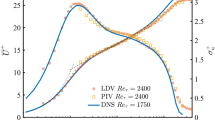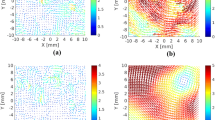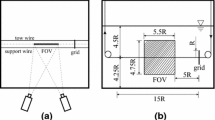Abstract
The identification and separation of multi-scale coherent structures is a critical task for the study of scale interaction in wall-bounded turbulence. Here, we propose a quasi-bivariate variational mode decomposition (QB-VMD) method to extract structures with various scales from instantaneous two-dimensional (2D) velocity field which has only one primary dimension. This method is developed from the one-dimensional VMD algorithm proposed by Dragomiretskiy and Zosso (IEEE Trans Signal Process 62:531–544, 2014) to cope with a quasi-2D scenario. It poses the feature of length-scale bandwidth constraint along the decomposed dimension, together with the central frequency re-balancing along the non-decomposed dimension. The feasibility of this method is tested on both a synthetic flow field and a turbulent boundary layer at moderate Reynolds number (\(Re_{\tau }\) = 3458) measured by 2D particle image velocimetry (PIV). Some other popular scale separation tools, including pseudo-bi-dimensional empirical mode decomposition (PB-EMD), bi-dimensional EMD (B-EMD) and proper orthogonal decomposition (POD), are also tested for comparison. Among all these methods, QB-VMD shows advantages in both scale characterization and energy recovery. More importantly, the mode mixing problem, which degrades the performance of EMD-based methods, is avoided or minimized in QB-VMD. Finally, QB-VMD analysis of the wall-parallel plane in the log layer (at \(y/\delta\) = 0.12) of the studied turbulent boundary layer shows the coexistence of large- or very large-scale motions (LSMs or VLSMs) and inner-scaled structures, which can be fully decomposed in both physical and spectral domains.
















Similar content being viewed by others
References
Agostini L, Leschziner M (2016) Predicting the response of small-scale near-wall turbulence to large-scale outer motions. Phy Fluid 28:1–015107. https://doi.org/10.1063/1.4939712
Agostini L, Leschziner MA (2014) On the influence of outer large-scale structures on near-wall turbulence in channel flow. Phy Fluids 26(7):075107
Al-Baddai S, Al-Subari K, Tom AM, Sol-Casals J, Lang EW (2016) A greens function-based bi-dimensional empirical mode decomposition. Inf Sci 348:305–321
Berkooz G, Holmes P, Lumley JL (1993) The proper orthogonal decomposition in the analysis of turbulent flows. Annu Rev Fluid Mech 25(1):539–575
Bernardini M, Pirozzoli S (2011) Inner/outer layer interactions in turbulent boundary layers: a refined measure for the large-scale amplitude modulation mechanism. Phys Fluids 23(6):061701
Blackwelder RF, Kaplan RE (1976) On the wall structure of the turbulent boundary layer. J Fluid Mech 76(01):89–112
Champagnat F, Plyer A, Le Besnerais G, Leclaire B, Davoust S, Le Sant Y (2011) Fast and accurate piv computation using highly parallel iterative correlation maximization. Exp Fluids 50(4):1169–1182
Chen J, Hussain F, Pei J, She ZS (2014) Velocity vorticity correlation structure in turbulent channel flow. J Fluid Mech 742:291–307
Chernyshenko SI, Marusic I, Mathis R (2012) Quasi-steady description of modulation effects in wall turbulence. ArXiv e-prints arXiv:1203.3714
Damerval C, Meignen S, Perrier V (2005) A fast algorithm for bidimensional emd. IEEE Signal Proc Lett 12(10):701–704
Del Álamo JC, Jiménez J, Zandonade P, Moser RD (2006) Self-similar vortex clusters in the turbulent logarithmic region. J Fluid Mech 561:329–358
Dragomiretskiy K, Zosso D (2014) Variational mode decomposition. IEEE Trans Signal Proc 62(3):531–544
Feng JJ, Wang JJ, Pan C (2011) Proper orthogonal decomposition analysis of vortex dynamics of a circular cylinder under synthetic jet control. Phy Fluids 23(1):014106
Guo H, Lian QX, Li Y, Wang HW (2004) A visual study on complex flow structures and flow breakdown in a boundary layer transition. Exp Fluids 37(3):311–322
Guo H, Borodulin VI, Kachanov YS, Pan C, Wang JJ, Lian QX, Wang SF (2010) Nature of sweep and ejection events in transitional and turbulent boundary layers. J Turbul 11:N34
Hamilton JM, Kim J, Waleffe F (1995) Regeneration mechanisms of near-wall turbulence structures. J Fluid Mech 287:317–348
Hellström LHO, Smits AJ (2014) The energetic motions in turbulent pipe flow. Phys Fluids 26(12):125102
Hellström LHO, Sinha A, Smits AJ (2011) Visualizing the very-large-scale motions in turbulent pipe flow. Phys Fluids 23(1):011703
Hellström LHO, Ganapathisubramani B, Smits AJ (2015) The evolution of large-scale motions in turbulent pipe flow. J Fluid Mech 779:701–715
Huang NE (2001) Computer implemented empirical mode decomposition method, apparatus, and article of manufacture for two-dimensional signals. US Patent 6311130
Huang NE, Long SR, Wu MC, Shih HH, Zheng Q, Yen NC, Tung CC, Liu HH (1998) The empirical mode decomposition and the hilbert spectrum for nonlinear and non-stationary time series analysis. Poc Math Phys Eng Sci 454(1971):903–995
Huang Y, Schmitt FG (2014) Time dependent intrinsic correlation analysis of temperature and dissolved oxygen time series using empirical mode decomposition. J Mar Syst 130:90–100
Huang Y, Biferale L, Calzavarin E, Sun C, Toschi F (2013) Lagrangian single-particle turbulent statistics through the hilbert-huang transform. Phys Rev E 87(4):041003 (Statistical, nonlinear, and soft matter physics)
Hunag YX, Schmitt FG, Lu ZM, Liu YL (2008) An amplitude-frequency study of turbulent scaling intermittency using empirical mode decomposition and hilbert spectral analysis. EPL (Europhysics Letters) 84(4):40010
Hutchins N, Marusic I (2007a) Evidence of very long meandering features in the logarithmic region of turbulent boundary layers. J Fluid Mech 579:1–28
Hutchins N, Marusic I (2007b) Large-scale influences in near-wall turbulence. Philos Trans Math Phys Eng Sci 365(1852):647–664
Hwang J, Lee J, Sung HJ, Zaki TA (2016) Inner-outer interactions of large-scale structures in turbulent channel flow. J Fluid Mech 790. https://doi.org/10.1017/jfm.2016.3
Hwang Y (2013) Near-wall turbulent fluctuations in the absence of wide outer motions. J Fluid Mech 723:264–288
Hwang Y, Bengana Y (2016) Self-sustaining process of minimal attached eddies in turbulent channel flow. J Fluid Mech 795:708–738
Jiménez J (2012) Cascades in wall-bounded turbulence. Ann Rev Fluid Mech 44(1):27–45
Kline S, Reynolds W, Schraub F, Runstadler P (1967) The structure of turbulent boundary layers. J Fluid Mech 30(04):741–773
Kovasznay LSG, Kibens V, Blackwelder RF (1970) Large-scale motion in the intermittent region of a turbulent boundary layer. J Fluid Mech 41(2):283–325
Lee J, Lee JH, Choi JI, Sung HJ (2014) Spatial organization of large-and very-large-scale motions in a turbulent channel flow. J Fluid Mech 749:818–840
Lee JH, Sung HJ (2011) Very-large-scale motions in a turbulent boundary layer. J Fluid Mech 673:80–120
Lehnasch G, Jouanguy J, Laval JP, Delville J (2011) POD Based Reduced-Order Model for Prescribing Turbulent Near Wall Unsteady Boundary Condition. Springer, Netherlands
Linderhed A (2009) Image empirical mode decomposition: a new tool for image processing. Adv Adapt Data Anal 01(02):265–294
Marusic I (2001) On the role of large-scale structures in wall turbulence. Phys Fluids 13(3):735–743. https://doi.org/10.1063/1.1343480
Marusic I, Kunkel GJ (2003) Streamwise turbulence intensity formulation for flat-plate boundary layers. Phys Fluids 15(8):2461–2464
Marusic I, Mathis R, Hutchins N (2010) Predictive model for wall-bounded turbulent flow. Science 329(5988):193–196
Mathis R, Hutchins N, Marusic I (2009a) Large-scale amplitude modulation of the small-scale structures in turbulent boundary layers. J Fluid Mech 628:311–337
Mathis R, Monty JP, Hutchins N, Marusic I (2009b) Comparison of large-scale amplitude modulation in turbulent boundary layers, pipes, and channel flows. Physics of Fluids 21(11). https://doi.org/10.1063/1.32677261
Mathis R, Hutchins N, Marusic I (2011) A predictive inner–outer model for streamwise turbulence statistics in wall-bounded flows. J Fluid Mech 681:537–566
Mazellier N, Foucher F (2011) Separation between coherent and turbulent fluctuations: what can we learn from the empirical mode decomposition? Exp Fluids 51(2):527–541
Musker AJ (1979) Explicit expression for the smooth wall velocity distribution in a turbulent boundary layer. AIAA J 17(6):655–657
Nunes JC, Bouaoune Y, Delechelle E, Niang O, Bunel P (2003) Image analysis by bidimensional empirical mode decomposition. Image Vis Comput 21(12):1019–1026
Pan C, Wang HP, Wang JJ (2013) Phase identification of quasi-periodic flow measured by particle image velocimetry with a low sampling rate. Meas Sci Technol 24(5):055305
Pan C, Xue D, Xu Y, Wang J, Wei R (2015) Evaluating the accuracy performance of Lucas-Kanade algorithm in the circumstance of piv application. Sci China Phys Mech Astron 58(10):1–16
Perry AE, Maruic I (1995) A wall-wake model for the turbulence structure of boundary layers. part 1. extension of the attached eddy hypothesis. J Fluid Mech 298:361–388
Schlatter P, Örlü R (2010) Quantifying the interaction between large and small scales in wall-bounded turbulent flows: a note of caution. Phys Fluids 22(5):051704
Smith C, Metzler S (1983) The characteristics of low-speed streaks in the near-wall region of a turbulent boundary layer. J Fluid Mech 129:27–54
Smits AJ, Mckeon BJ, Marusic I (2011) High–Reynolds number wall turbulence. Annu Rev Fluid Mech 43:353–375
Tomkins CD, Adrian RJ (2003) Spanwise structure and scale growth in turbulent boundary layers. J Fluid Mech 490:37–74
Tomkins CD, Adrian RJ (2005) Energetic spanwise modes in the logarithmic layer of a turbulent boundary layer. J Fluid Mech 545:141–162
Vallikivi M, Hultmark M, Smits AJ (2015) Turbulent boundary layer statistics at very high reynolds number. J Fluid Mech 779:371–389
Waleffe F (1997) On a self-sustaining process in shear flows. Phys Fluids (1994-Present) 9(4):883–900
Wu Y, Christensen KT (2010) Spatial structure of a turbulent boundary layer with irregular surface roughness. J Fluid Mech 655:380–418
Wu Z, Huang NE, Chen X (2009) The multi-dimensional ensemble empirical mode decomposition method. Adv Adapt Data Anal 1(3):339–372
Zhang C, Chernyshenko SI (2016) Quasisteady quasihomogeneous description of the scale interactions in near-wall turbulence. Phys Rev Fluids 1(014):401
Acknowledgements
This work was supported by both the National Natural Science Foundation of China (Grant Nos. 11372001, 11672020 and 11490552) and the Fundamental Research Funds for the Central Universities of China (No. YWF-16-JCTD-A-05).
Author information
Authors and Affiliations
Corresponding author
Electronic supplementary material
Below is the link to the electronic supplementary material.
Rights and permissions
About this article
Cite this article
Wang, W., Pan, C. & Wang, J. Quasi-bivariate variational mode decomposition as a tool of scale analysis in wall-bounded turbulence. Exp Fluids 59, 1 (2018). https://doi.org/10.1007/s00348-017-2450-7
Received:
Revised:
Accepted:
Published:
DOI: https://doi.org/10.1007/s00348-017-2450-7




